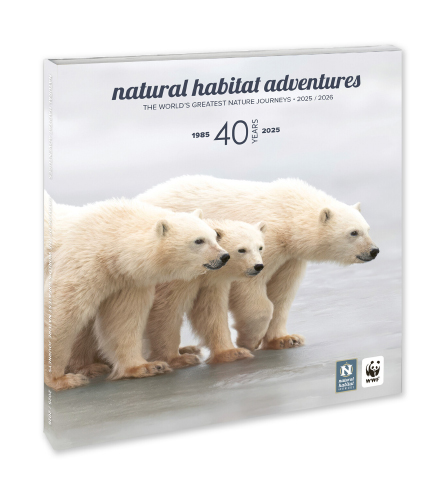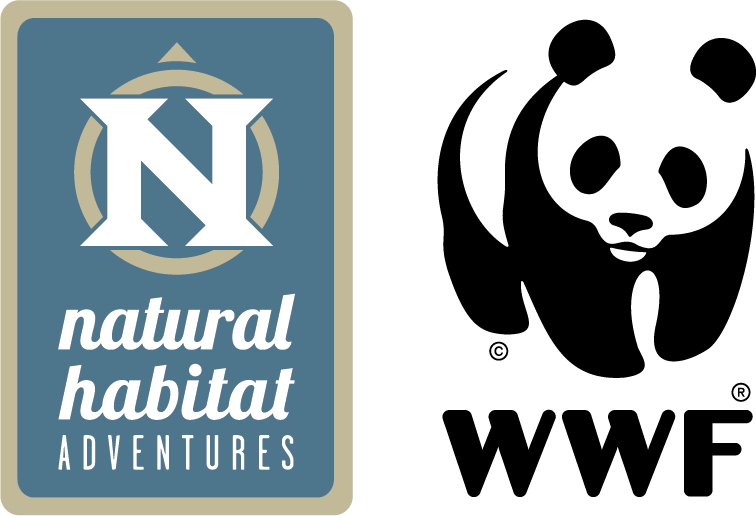For many people, our first encounters with vultures are as dark, shadowy, even menacing figures in fairy tales. That’s a shame, because vultures play helpful, even indispensable, roles maintaining ecological balance across five continents. They contribute to human health and even anti-poaching efforts in remarkable, rarely lauded ways.
Recent work around our Snow Leopard Himalayan itineraries has gotten me hooked on learning about bearded vultures, and vultures’ essential roles as nature’s clean up crews—they’re fascinating!
Here are the basics and where you can spot vultures in the wild, too.

Bearded Vulture Basics
Bearded vultures (Gypaetus barbatus), also known as lammergeiers or ossifrage (Latin for “bone breaker”), are among the most striking members of the vulture family. They are uniquely adapted to thrive in rugged, high-altitude environments and play a vital role in maintaining the balance of their ecosystems.
Ecologists estimate that there are between 2,000 and 10,000 living lammergeiers.

Bearded Vulture Size and Appearance:
- Bearded vultures are one of the largest birds of prey, with a wingspan of 7.5 to 9 feet (2.3 to 2.8 meters) and a weight ranging from 10 to 16.5 pounds (4.5 to 7.5 kilograms).
- Their striking plumage features dark wings, a pale body, and a dramatic red “mask” around the eyes, with feathers that often appear orange due to iron oxide from mud-bathing.
- These impressive birds are built for soaring, allowing them to cover vast territories in search of food. All vultures have very long, broad wings that allow them to soar gracefully at great heights, catching the thermals and remaining aloft for hours with minimal effort. With their keen eyesight, they can scan for carrion or spot other vultures descending to prey from miles away.

Bone-Eating Vulture Specialists:
- Bearded vultures are renowned for their diet, which consists almost entirely of bones—up to 90% of their intake. This unique adaptation gives them access to calcium and phosphorus, essential nutrients often unavailable to other scavengers.
- To crack large bones, they drop them from heights of 150 to 500 feet onto rocky surfaces, a behavior that has earned them the nickname ossifrage—”bone breakers.” This extraordinary preference gives them access to critical nutrients like calcium and phosphorus, essential for survival.
- Their stomachs are highly specialized, with acidic digestive juices capable of dissolving bone fragments within 24 hours—it’s the same pH as battery acid! This adaptation allows bearded vultures to thrive in rugged environments where food is scarce, and where other scavengers might struggle to find sufficient nourishment.

Bearded Vulture Habitat and Range:
- These birds inhabit mountainous regions across Europe, Africa and Asia, nesting on high cliffs to avoid predators and disturbance.
- Key ranges include the Alps, Pyrenees, Caucasus, Ethiopian Highlands and the Himalayas. They prefer areas with abundant ungulate populations, which provide a steady supply of carcasses.

Bearded Vulture Conservation Status:
- Listed as Near Threatened by the IUCN, bearded vultures face threats from habitat loss, poisoning (both intentional and accidental) and reduced food availability.
- In Europe, reintroduction programs have successfully boosted populations in the Alps, where they were previously extinct. Efforts focus on preventing poisoning incidents and ensuring safe food supplies.

Where to Spot Vultures in the Wild
Natural Habitat Adventures provides opportunities to witness various vulture species across different destinations:
- Griffon Vultures in Croatia & Slovenia: On Nat Hab’s Croatia & Slovenia Nature Adventure, guests spot griffon vultures soaring over the Adriatic landscapes.
- Turkey Vultures in the Grand Canyon: The United States is home to three of the vulture species listed above: turkey vultures, black vultures and the endangered California condor. Grand Canyon National Park is home to turkey vultures, easily spotted gliding over the vast canyon vistas. Guests on two Nat Hab trips, the Grand Canyon, Bryce and Zion itinerary or our Grand Canyon & Sedona Explorer, spot turkey vultures over the Grand Canyon.
- African Vultures on Safari: African safaris in Zimbabwe, Botswana, Kenya, Namibia, South Africa and Tanzania offer sightings of several vulture species, including the lappet-faced, white-backed and Rueppeli’s vultures, integral to savanna ecosystems.

Adult bearded vulture among griffon vultures in Europe
Benefits of Vultures in Ecosystems Worldwide
Vultures are a diverse group of scavenging birds found on every continent except Australia and Antarctica. Globally, there are 23 vulture species, each playing a vital role in their respective ecosystems.
Human Health Benefits: Vultures’ scavenging behavior is crucial for ecosystem health, preventing disease outbreaks and recycling nutrients. Their decline can lead to increased carcass accumulation, resulting in higher incidences of diseases.
The health benefits to humans of vultures should not be understated—WWF has shared that in India, hundreds of thousands of human deaths are said to be traced back to the collapse of the vulture population.
Anti-Poaching Support: WWF recently invested in tracking white-backed vulture movements. White-backed vultures play a pivotal role in their African ecosystems, including helping to detect animals killed illegally by poachers.

White-backed Vulture, Kruger National Park, South Africa
Information from collaring vultures will inform wildlife movement and distribution in the Zimbabwe portion of the Kavango-Zambezi Transfrontier Conservation Area (KAZA). Collaring vultures allows researchers to do a few different and important things:
- Track movement patterns and foraging habits: By tracking foraging behaviors like migratory routes and habitat use, researchers can improve conservation strategies. Vultures travel long distances at low energy cost, a skill they need to find food. Tagging other animals such as zebras has allowed us to better understand incredible, cross-continental movements, and we are interested to see how vultures play into this activity.
- Connect vultures with mammal movements: Vulture movements often align with those of large mammals. Tracking them will provide more insight into how other wildlife in the area interact with the landscape.
- Monitor environmental health and poaching activities: Changes in vulture populations and behavior signal shifts in the ecosystem, possibly due to human activities or climate change. Tagged vultures have also been used as sentinels for poaching activities and have even led authorities to discover incidents where animals are poisoned.

Griffon Vultures
Vulture Species Worldwide
Vulture species vary widely, from the massive Andean condor in South America to the critically endangered white-backed vulture in Africa. Each of the 23 vulture species has adapted to specific habitats and feeding behaviors, contributing uniquely to ecosystem health.
Vultures are categorized into two groups: New World vultures are found in North and South America and are represented by seven species belonging to five genera. Old World vultures are found throughout the continents of Africa, Asia and Europe and are represented by 16 species belonging to nine genera. The two groups are not genetically closely related; instead, their similarities are due to convergent evolution (species have different ancestral origins and have developed similar features).

Indian Vulture
Old World Vultures (Family: Accipitridae):
- Griffon Vulture (Gyps fulvus):
Habitat: Europe, North Africa, and parts of Asia; commonly found in mountainous regions and open plains, including thriving populations on the Iberian Peninsula, in the Balkans, and across the Alps. - White-backed Vulture (Gyps africanus):
Habitat: Sub-Saharan Africa; prefers savannas and woodlands. - Rueppell’s Vulture (Gyps rueppelli):
Habitat: Central and East Africa; inhabits savannas and grasslands. - Himalayan Vulture (Gyps himalayensis):
Habitat: Himalayan ranges; found in high-altitude regions. - Indian Vulture (Gyps indicus):
Habitat: Indian subcontinent; resides in cities, towns, and countryside. - Slender-billed Vulture (Gyps tenuirostris):
Habitat: South and Southeast Asia; favors lowland regions. - Cape Vulture (Gyps coprotheres):
Habitat: Southern Africa; prefers cliffs and open savannas.

Hooded Vulture
- Hooded Vulture (Necrosyrtes monachus):
Habitat: Sub-Saharan Africa; commonly found near human settlements. - Lappet-faced Vulture (Torgos tracheliotos):
- Habitat: Africa and the Middle East; inhabits arid savannas and deserts.
- Cinereous Vulture (Aegypius monachus):
Habitat: Southern Europe, Asia, and parts of the Middle East; prefers forested mountains. - Egyptian Vulture (Neophron percnopterus):
Habitat: Southern Europe, Africa, and South Asia; found in open terrains. - Bearded Vulture (Gypaetus barbatus):
Habitat: Mountainous regions in Europe, Africa, and Asia. - Red-headed Vulture (Sarcogyps calvus):
Habitat: Indian subcontinent and Southeast Asia; prefers open country. - White-headed Vulture (Trigonoceps occipitalis):
Habitat: Sub-Saharan Africa; found in savannas and woodlands. - Palm-nut Vulture (Gypohierax angolensis):
Habitat: West and Central Africa; associated with palm trees and wetlands.
The palm nut vulture is unique among vultures for its diet, which includes palm nuts and carrion, aiding in seed dispersal and carcass disposal. - Indian White-rumped Vulture (Gyps bengalensis):
Habitat: South and Southeast Asia; commonly found near human habitation.

Turkey Vultures
New World Vultures (Family: Cathartidae):
- Turkey Vulture (Cathartes aura):
Habitat: Widespread across the Americas; adaptable to various environments.
The turkey vulture possesses a keen sense of smell to locate carrion, preventing disease spread. - Black Vulture (Coragyps atratus):
Habitat: Americas; found in open areas and near human settlements. - California Condor (Gymnogyps californianus):
Habitat: Western United States; inhabits rocky shrubland and coniferous forests. - Andean Condor (Vultur gryphus):
Habitat: South American Andes; prefers open grasslands and alpine regions.

California Condor at Grand Canyon National Park
Threats to Vulture Populations
Vultures face unprecedented threats, which have led to alarming population declines worldwide. These declines have profound ecological and human health implications, underscoring the urgency of effective conservation measures.
Across Africa, vulture populations have catastrophically declined over the last 50 years, with overall decline rates of up to 97%. Today, 7 out of 11 African-Eurasian vulture species are at risk of extinction, underlining this decline.
Poisoning:
- Intentional Poisoning: In Africa, poisoning accounts for over 60% of vulture deaths. Farmers targeting predators like lions inadvertently poison vultures that consume the tainted carcasses. In West Africa, vultures are hunted for traditional medicine and rituals.
- Veterinary Pharmaceuticals: The veterinary drug diclofenac caused a 99.9% decline in white-rumped vultures in South Asia within two decades. Even minimal residues in livestock carcasses are lethal to vultures.
Electrocution and Collisions:
- Vultures are susceptible to collisions with energy infrastructure, including power lines and wind turbines, leading to fatalities.
Habitat Loss:
- Expansion of agriculture and urban development encroaches on vulture habitats, reducing nesting and foraging areas.
Ecological and Human Health Consequences
The decline of vulture populations has led to increased carcass decomposition times, resulting in higher populations of scavengers like rats and feral dogs. This shift has been linked to the spread of diseases such as rabies and anthrax, with studies estimating an additional 500,000 human deaths in India between 2000 and 2005 due to the collapse of vulture populations.

Andean Condor
Vulture Conservation and Its Impact
Legislation and Policy Changes:
- Banning Harmful Drugs: India banned veterinary diclofenac in 2006, leading to stabilization of vulture populations, though recovery remains slow.
Captive Breeding and Reintroduction:
- The Jatayu Conservation Breeding Center in India has successfully bred and released critically endangered vultures, contributing to population restoration.
Community Engagement and Education:
- Numerous programs in Africa educate communities on the ecological importance of vultures, promoting coexistence and reducing persecution.
Research and Monitoring:
- Organizations like the Vulture Conservation Foundation conduct research to inform conservation strategies, including tracking vulture movements and studying their ecology.
- In India, WWF announced Vulture Count 2024, a crucial citizen-science initiative aimed at monitoring and conserving India’s vulture populations.
Vultures play a critical role in maintaining ecosystem health and preventing disease transmission. Addressing the threats they face through comprehensive conservation efforts is essential not only for their survival but also for the well-being of human populations.

California Condor



























